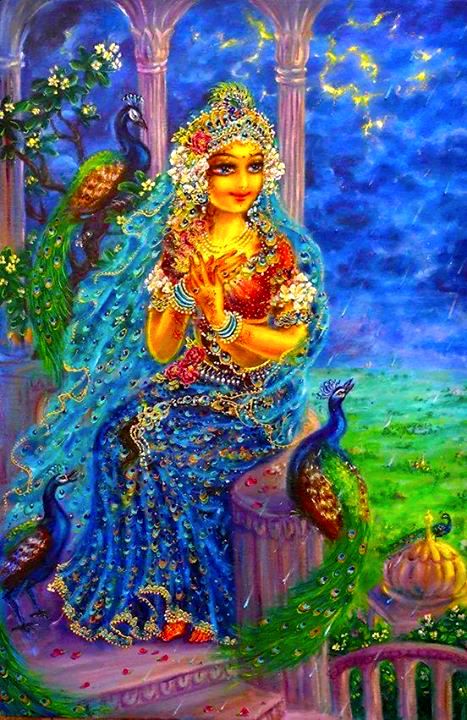Mahanidhi Madan Gopal Das
This series of posts presents the facts (tattva) regarding the identity, moods (gopi-bhava), intimacy and sevas of Srimati Radharani’s beautiful, talented handmaidens known as manjaris, kinkaris, or dasis. Many wonderful lilas are also presented to highlight the manjaris intimate sevas to Srimati Radhika and Her beloved Krishna.
The information here comes from the commentaries of Advaitavamsa Acharya 108 Sri Ananda Gopala Goswami and 108 Sri Ananta Dasa Babaji Maharaja on “Vilapa Kusumanjali” and “Radha Rasa Sudhanidhi” translated by Sri Advaita Dasji.
Manjaris Pray for Radha Seva
Sri Raghunatha Das Goswamipada’s heart is full of loyalty to Sri Radha. He is not satisfied just with smarana or visions of Radha, so even in external consciousness he prays to Radharani and laments. The waves of prayers carry his mind into the kingdom of Radha Govinda lila.
Manjari bhava sadhakas should pray to attain closeness to Radharani and the chance to render their eternal personal seva to Sri Radha. Such prayers are expressions of love and nourish one’s Radha bhakti. For sure Radha hears every prayer of Her manjari sadhakas.
Srimad Bhagavatam (10.28.3) says, “Not seeing Nanda Baba, the cowherd men loudly cried out, “O Krishna!” Bhagavan Sri Krishna heard their cries and understood that His father had been captured by Varuna so He immediately came there.”
Visvanatha Cakravartipada tika:
The Sanskrit word upa-shrutya in this verse means that Krishna heard the cries for help from close by even though Krishna was 30 kilometers away! So sadhakas should firmly believe that Radharani will hear and respond to our prayers for seva, mercy and darshan because Radha is always near Her manjaris, sthitam nityam parshve. (Radha Rasa Sudhanidhi 53)
Vishakha Sakhi Kunja
In Vilap Kusumanjali, Sri Raghunatha Das Goswamipada only mentions one kunja at Radha Kunda namely Visakha’s because he is in Sri Advaita Prabhu’s Parivar whose yutheshvari is Visakha-sakhi.
Tulasi manjari takes eager Srimati to meet Krishna in Madana Sukhada-kunja, the kunja that gives erotic joy to Radha-Krishna, on the bank of Radha Kunda. Unlike Lalita’s opulent kunja, Visakha’s simple, natural kunja is beautified with different flowers and buzzing bees.
On the inside walls of the kunja the manjaris have drawn erotic pictures to incite lusty feelings in Radha Madhava. This kunja is managed by Visakha-sakhi. On all four sides are Campaka trees that fill the kunja with the fragrance of their red, green, yellow, and blue flowers. Madhavi flower vines entwine the branches of these trees to create a palace like atmosphere! Blue, yellow, and green parrots, mynas and cuckoos sing sweet songs.
It has four gates made of bamboo stakes with various wonderful flowers strung on them. Thirsty humming bees serve as doorkeepers to keep away any intruders. Their excited humming is like the ringing of Cupid’s bells during Yugala Kishora’s love battles. The central courtyard of this kunja is studded with jewels forming a sixteen-petaled lotus flower design. Visakha’s shishya Manjumukhi oversees Madana Sukhada kunja, which is situated on the northeast bank of Radha Kunda. This beautiful kunja is the very form of prema-rasa and it always inundates Radhe-Shyam in a nectar flood of amorous pastimes.
Radhe-Shyam Darshan Bewilderment
Shyam anxiously waits for Swamini in Visakha-sakhi’s kunja. Sometimes Shyam steps outside eagerly looking for Radha coming on the pathway. Hari’s heart startles with joy when He hears the dry leaves falling from the trees, thinking His beloved Priyaji is coming. Suddenly Shyam sees a golden effulgent form approaching and He thinks to Himself:
“Is this the devata of youthful beauty or sweetness personified? A flood of natural beauty or a river of bliss? Or is it My beloved Sriji coming here to delight My senses?”
Love-excited Radhika muses in Her own bewilderment upon seeing Shyam in the distance:
“Is this Cupid? No, because Cupid has no body! Is it a nectar ocean of madhurya rasa? Is this a blossoming tree of love from heaven? No, because trees cannot walk. Is it then maybe My Priyatama, whom I am desiring for so long?”
Manjari Single Pillow Bed
Understanding Radhe-Shyam’s feelings Tulasi manjari has already prepared a flower bed in the kunja. Although it is summer, all the other five seasons stand by to serve whenever necessary. Time, sky, wind, sun and moon all stand by to serve Radha-Krishna’s lila. In Vraja, everything and everyone serves Yugal’s sweet pastimes. Tulasi manjari has covered the flower bed with a thin satin sheet, so that it will not fall apart when Radha-Krishna enjoy there.
It is a single bed with a single pillow made of fresh flower petals. Why a single pillow? That will be understood when the Yugala Kishora lie down there. The picture of that pastime had appeared in the manjari’s mind beforehand. Manjari bhava sadhakas should meditate on the mystery of this one pillow bed, and see what beautiful lilas arise in their hearts purified and sweetened by Krishna nama bhajan!
Sri Radha’s manjaris ki jai! Jai Jai Sri Radhe!

